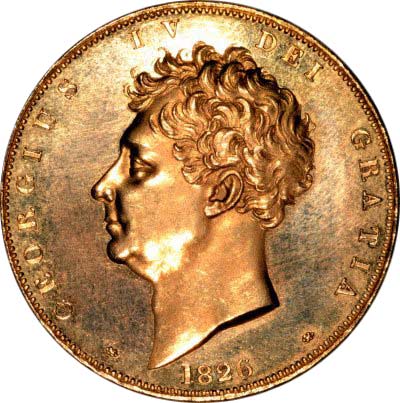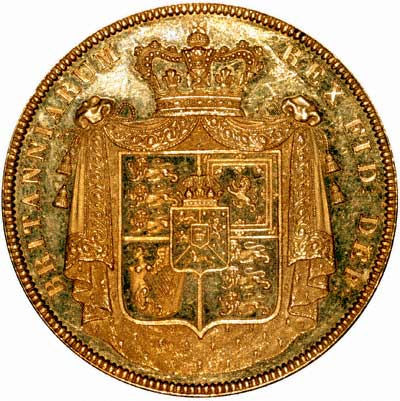|
1826 George IV Gold Coin Proof Set
Proof & Specimen Sets
Up until relatively recent times, 1970 or thereabouts, the Royal Mint appears not to have referred to proof coins and sets as "proof", preferring to use the word "specimen". This can create confusion and ambiguity. We will attempt to explain and clarify.
Specimen
The word "specimen" simply means any individual item or sample used as representative to study or illustrate all examples of its type or class.
From this, it follows that a coin specimen could be any coin of its type, date, or design, and not necessarily one with any special finish, or in any particular condition or grade. However, as mints have from time to time made sample coins available to individuals, whether mint officials, VIPs or collectors, it will often have been their practice to select a particularly nice sample, and perhaps even to produce samples prepared and struck with extra care and attention. It must have been a natural progression for these "sample" or "specimen" coins, to have acquired some form of nomenclature to differentiate them from their mass produced counterparts, and at some time in the past, the word "specimen" is the label which was applied to them.
It follows from this that not all "specimen" coins or sets will be "proof" ones, but it does so happen that many of them are in fact what we would now classify as proofs.
Proof
As the word "specimen" is somewhat ambiguous, it seems quite sensible and desirable that the word "proof" has been applied to coins and sets which would previously have been described as "specimens".
What most coin collectors, dealers, and mints would now call proof include those coins struck from polished blanks with a highly polished mirror finish. In recent years only the field (background) is mirror finished, while the raised part of the designs receive a matt finish, but before then, many proofs had a high polish on all parts including the raised areas. It seems almost universally recognised that the mirror finish background in combination with a matt raised design is the best and most pleasing way to produce a proof coin.
Occasionally, mints use a reverse-proof design, where the raised parts are highly polished while the background is matt, but this tends to be less popular, and is less aesthetically pleasing for most coin designs.
Some proof coins and sets are issued with an all matt design, The United Kingdom 1902 Coronation coin sets, for example, were all issued with a matt finish on all parts of the coins. We do not know why.
Proof Etymology
Let's examine the meaning of the word "proof".
In printing, a proof is a trial print, often a single sheet of paper, which is printed for the purpose of checking, correcting, and approving its content and correct rendition of its print quality, and colour rendition. This may actually be inferior to the final production quality, even though it may have been produced in small quantities.
Another meaning is the determination of the quality of something by testing, as for example in the Trial of the Pyx, an annual event in which British and other coins produced the the Mint are tested.
If a new coin design requires approval by the monarch, government official, engravers, or other mint personnel, it would seem natural to prepare and present samples which were as good as possible, and superior to those which would eventually be mass produced for circulation. This special treatment could often have included polishing the raised parts of the dies, which would produce the fields of the coins, and sand-blasting the incuse parts of the dies which would produce the raised parts of the coins. It would also be sensible to use multiple strikes to obtain the best possible sharpness. Running the coining press at lower speed, and with different pressure would also affect the final results. Polishing the blanks (planchets) would also help to achieve the maximum possible quality of finished article.
1826 Sets
In 1826, a new portrait was used on British gold and silver coins. It was introduced 1824 and used until his death in 1830.
At the time these sets were issued, it appears they were called "specimen" coins, although we would nowadays call them proofs.
The Eleven Coins
The eleven coins in the set include the four gold coins, the gold sovereign and half sovereign, along with the two pound coin, often called a double sovereign, and a five pound gold coin.
The seven remaining coins are crown (five shillings), halfcrown, shilling, sixpence, penny, half penny and farthing.
Specifications - Gold
All composed of 22 carat gold (91.66% pure).
|
Denomination | Diameter | Weight | AGW* | Description
| |
Five Pounds | 36.02 | 39.94 | 1.1771 | Crowned Shield & Mantle
| |
Two Pounds | 28.40 | 15.98 | 0.4708 | Crowned Shield & Mantle
| |
Sovereign (Pound) | 22.05 | 7.99 | 0.2354 | Crowned Shield
| |
Half Sovereign (Fifty Pence) | 19.30 | 3.99 | 0.1177 | Crowned Shield
| |
Total | | 67.90 | 2.0011 |
|
Specifications - Silver & Copper
|
Denomination | Diameter | Weight | Alloy | ASW | Description
| |
Crown - Five Shillings | 38.61 | 28.2759 | 0.925 Silver | 0.8409 | St George & Dragon
| |
Halfcrown (Two Shillings and Six Pence) | 32.31 | 14.380 | 0.925 Silver | 0.4205 | Crowned Shield in Garter and Collar
| |
Shilling | 23.59 | 5.6552 | 0.925 Silver | 0.1682 | Lion on Crown
| |
Sixpence | 19.41 | 3.0100 | 0.925 Silver | 0.0895 | Lion on Crown
| |
Penny | 34 | | Copper | | Britannia with Shield
| |
Half Penny | 28 | | Copper | | Britannia with Shield
| |
Farthing | 22 | | Copper | | Britannia with Shield
| |
Total | | 69.2511 | 0.925 Silver | 1.5191 |
|
Notes on Tables
Weight = gross weight in grams.
AGW = Actual pure gold weight in troy ounces.
ASW = Actual pure silver content in troy ounces.
Prices & Availability
Please contact us prior to ordering for current prices and availability.
|
Date | Description | From | Mintage | Grade | Stock | Price £ | Price $
| |
1826 | Official 11 Coin Proof or Specimen Set | £5 | | FDC | Wanted | £Ask | $Ask
|
More Information
More information about British gold sets is available on our British Gold Sets Information page.
You may wish to use our order form.
Postage & Packing
UK Registered Post (Special Delivery) £9 per order, plus £1 per £1,000
EU Insured Post £10 per order, plus £1 per £1,000
USA Airmail $10,
Insured Shipping $20, plus $1 per $1,000
Canada Airmail $15,
Insured Shipping via Fedex $60, plus $1 per $1,000
|
|

Obverse of 1826 Gold Proof Five Pound
British Gold Sets Information

Reverse of 1826 Gold Proof Five Pound
|


